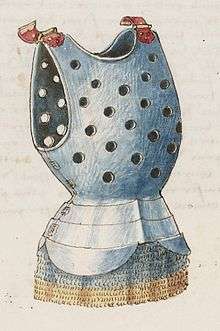Gambeson
A gambeson (also aketon, padded jack or arming doublet) is a padded defensive jacket, worn as armor separately, or combined with mail or plate armor. Gambesons were produced with a sewing technique called quilting. They were usually constructed of linen or wool; the stuffing varied, and could be for example scrap cloth or horse hair. During the 14th century, illustrations usually show buttons or laces up the front.
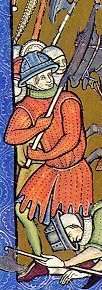
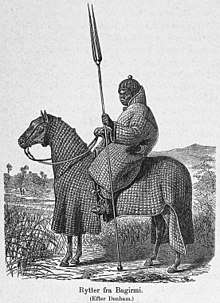
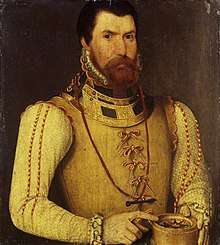
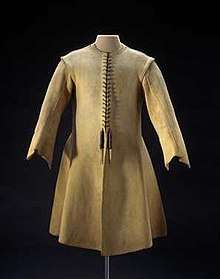
An arming doublet (also called aketon) worn under armor, particularly plate armor of fifteenth- and sixteenth-century Europe, contains arming points for attaching plates. Fifteenth century examples may include goussets sewn into the elbows and armpits to protect the wearer in locations not covered by plate. German gothic armor arming doublets were generally shorter than Italian white armor doublets, which could extend to the upper thigh. In late fifteenth century Italy this also became a civilian fashion. Men who were not knights wore arming doublets, probably because the garment suggested status and chivalry.[1]
Etymology
The term gambeson is a loan from Old French gambeson, gambaison, originally wambais, formed after the Middle High German term wambeis "doublet", in turn from Old High German wamba "stomach" (cognate to womb).[2]
The term aketon, originally medieval French alcottonem, might be a loan from Arabic al-qutn "cotton" (definite article – "the cotton").
In medieval Norse, the garment was known as vápntreyja, literally "weapon shirt", or panzari/panzer.[3] Treyja is a loan from (Middle) Low German.[4] Panzari/panzer is probably also a loan from (Middle) Low German, though the word has its likely origin in Italian, and is related to Latin pantex 'abdomen',[5] cognate with English paunch.[6]
History
Quilted leather open jackets and trousers were worn by Scythian horsemen before the 4th century BC, as can be seen on Scythian gold ornaments crafted by Greek goldsmiths. The European gambeson can be traced at least to the late 10th century, but it is likely to have been in use in various forms for longer than that. In Europe, its use became widespread in the 13th century, and peaked in the 14th and 15th centuries.
The gambeson was used both as a complete armor unto itself and underneath mail and plate in order to cushion the body and prevent chafing. It was very insulating and thus uncomfortable, but its protection was vital for the soldier.
Although they are thought to have been used in Europe much earlier, gambesons underwent a revolution from their first proven use in the late 11th and early 12th centuries as an item of armor that simply facilitated the wearing of mail to an item of independent armor popular amongst infantry. Although quilted armor survived into the English Civil War in England as a poor man's cuirass, and as an item to be worn beneath the few remaining suits of full plate, it was increasingly replaced by the 'buff coat' – a leather jacket of rough suede.
There are two distinctive designs of gambeson: those designed to be worn beneath another armor, and those designed to be worn as independent armor. The latter tend to be thicker and higher in the collar, and faced with other materials, such as leather, or heavy canvas. This variant is usually referred to as padded jack and made of several (some say around 18,[7] some even 30[8]) layers of cotton, linen or wool. These jacks were known to stop even heavy arrows[8] and their design of multiple layers bears a striking resemblance to modern day body armor, which substituted at first silk, ballistic nylon and later Kevlar as fabric.
For common soldiers who could not afford mail or plate armor, the gambeson, combined with a helmet as the only additional protection, remained a common sight on European battlefields during the entire Middle Ages, and its decline – paralleling that of plate armor – came only with the Renaissance, as the use of firearms became more widespread, until by the 18th century it was no longer in military use.
While the use of linen has been shown in archaeological evidence, the use of cotton – and cotton-based canvas – is disputed since large amounts of cotton cloth were not widely available in northern Europe at this time. It is quite probable that Egypt (and Asia-Minor generally) still produced cotton well after the 7th and 8th centuries and knowledge (and samples) of this cloth was brought to Europe by the returning Crusaders; however, the logistics and expense of equipping a town militia or army with large amounts of cotton-based garments is doubtful, when flax-based textiles (linen) were in widespread use.
Linothorax was a type of armor similar to gambeson used by ancient Greeks. Meanwhile, the Mesoamericans were known to make use of quilted cotton armor called Ichcahuipilli before the arrival of the Spaniards. Another example is the bullet resistant Myeonje baegab that was created in the Joseon Dynasty in an attempt to confront the effects of Western rifles.
See also
- Doublet (a.k.a. pourpoint)
- Buff coat
- Jack of plate
References
- Breiding, Dirk H. "Fashion in European Armor, 1400–1500". Department of Arms and Armor, The Metropolitan Museum of Art.
- "Gambeson". Merriam-Webster.
- Heggstad, Leiv; Hødnebø, Finn; Simensen, Erik (2008) [1909]. Norrøn Ordbok. Oslo: Det norske samlaget. pp. 477, 703–704. ISBN 8252171508. OCLC 768091918.
- "trøye". Bokmålsordboka (in Norwegian). University of Bergen. Retrieved 29 March 2020.
- "panser". Bokmålsordboka (in Norwegian). University of Bergen. Retrieved 29 March 2020.
- "paunch". Oxford English Dictionary (3rd ed.). Oxford University Press. September 2005. Retrieved 29 March 2020. (Subscription or UK public library membership required.)
- Embleton, Gerry (2001). Medieval Military Costume: Europa Militaria Special. Crowood Press UK. p. 67. ISBN 978-1-86126-371-1.
- Embleton, Gerry; Howe, John (1994). Söldnerleben im Mittelalter. Motorbuchverlag. p. 47.
External links
| Wikimedia Commons has media related to Gambeson. |
- "The Function of Armor in Medieval and Renaissance Europe". The Metropolitan Museum of Art.
- How a man shall be armed for his ease when he shall fight on foot a translation of the mid-fifteenth century treatise on armor, translated into modern English and accompanied by pictorial references.
